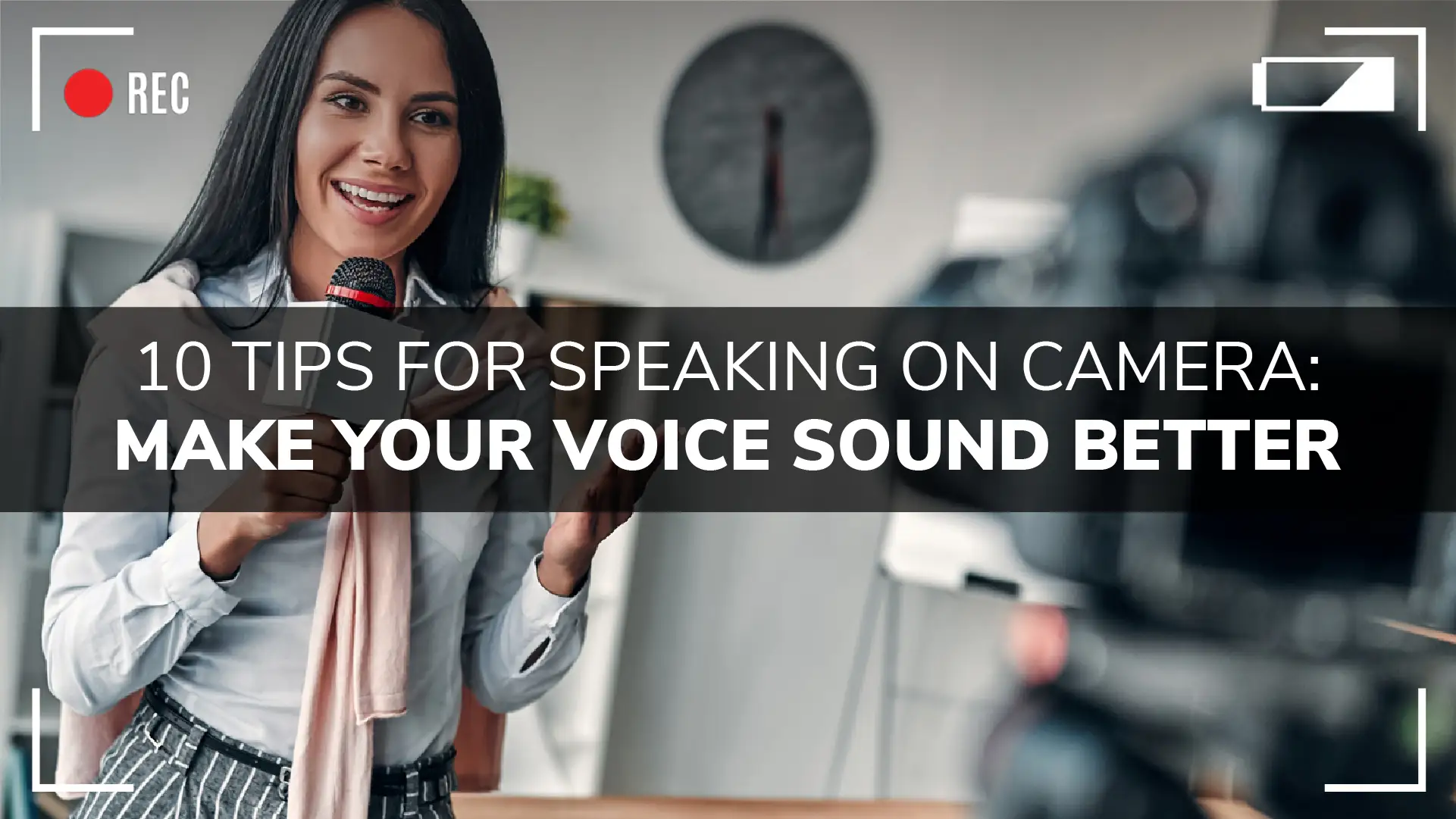Studies have found that how your voice sounds is twice as important as what you say.
It’s why confident speakers know how to use the variety in their voice to their advantage. Your public speaking persona is the “you” that you bring to any media appearance: confident, polished, and prepared.
You have the ability to control your voice more than you realize.
When rehearsing and thinking about how your audience is going to be listening to you, there are a few different things to consider if you want to sound better on camera.
In this blog post, you'll learn about how to improve your speaking voice. That includes voice power, vocal variety, tone, inflection, pacing, and pausing—and how it’s different on camera than in person.
Tip 1: Want a Clear Voice on Camera? Consider The Technology.
No matter the setting for your media appearance, be aware of the technical options available to help you sound better and possible distractions that can cause issues.
For example, if you’re going to be recording yourself or going live from your home, consider background noise like an air conditioner, refrigerator ice maker, or your dog who also has something to say. Turn off any loud appliances before you go live and let those you live with know that you need their silence.
These noises are easily picked up by internal microphones such as the kind built into your laptop or phone. An external microphone, like a headset, USB microphone, or lapel mic will be much better at only picking up your voice and ignoring background noise.
The good news is, if you are going to be speaking from a news station or somewhere else with a professional setup, they will likely handle this for you. However, it doesn’t hurt to ask what their setup is beforehand so you can be prepared.
Tip 2: Do A Proper Warm Up To Ensure Your Voice Is At Its Best
A pro athlete wouldn't take to the field without stretching and nor would a news anchor go in front of the camera without doing a proper vocal warm up.
Your vocal chords are muscles that need to be stretched and worked out to work at their best. So before getting in front of the camera, take a few moments to loosen up your face and jaw muscles by trying these exercises:
- Make big yawning motions with your mouth
- Do exaggerated chewing movements
- Close your lips and blow air through them to rumble them
- Hum for five full breaths
Whether your voice tends to quiver or you have a habit of speaking too fast, Fia breaks down the techniques to overcome common speaking issues in the video below.
Tip 3: Give Your Voice More Energy Than Normal
The most dynamic and memorable public speakers don't appear that way by accident.
Just as the camera can add ten pounds (depending on the lens used), it can also cut your energy in half. If you aren't excited and passionate about what you're talking about, you can't expect your audience to be either.
There’s a reason we all know that watching something on a screen isn’t the same as attending it live. In person, you can feel the energy of the speaker and the crowd much easier.
However, you may also have gotten goosebumps from exceptionally good performances even when seeing them at home on a device. What makes these so powerful is that the speaker is going all out and giving 100% of their energy and passion to the audience. Their emotion is so clear that mirror neurons in your premotor cortex ‘mirror’ them and cause you to feel the same emotion.
If you want to achieve a similar on-camera presence, this is where recording your speaking practice comes in handy.
Try recording once with your normal energy output and another time bumping up the energy 50%. Do you see and feel the difference? Your audience definitely will.
Tip 4: The Context Changes How Much You Need To Project
Whenever you have a media engagement, be mindful of what kind of technology is being used and how close or far away you are from the microphone to make sure you speak at an appropriate volume for the setting.
If you have professional technical support during your media appearance, don’t be afraid to ask for their help in what will make you look and sound your best.
If you’re at home, just like with your energy, record yourself speaking at various volumes into your microphone to hear how it sounds. Listen with both your speakers and headphones to ensure you find the right balance.
Here are some examples:
- Prerecorded Media
From podcasts to interviews, when your media opportunity is prerecorded you can be more relaxed with how you project. This means if you happen to yell in excitement or go too quiet at certain points, they have the ability to fix the volume in the editing process. So you can be as loud and animated as you like without worrying too much about how it will affect the listeners. - Live Streamed Events
In contrast, when you’re live, people could be watching on TV, through their computer speakers, or headphones. This means if you’re suddenly very loud, you may literally be yelling into someone’s ear. To be safe, match the volume of your host and put more energy into your movements rather than your voice.
Tip 5: Learn To Breathe - But Not The Way You’re Used To
Actors are taught this technique and we want to share it with you as one of the media training basics.
Controlling your voice, in reference to volume or steadiness, requires controlling your breath. A bonus to this exercise is that controlling your breath can also help you lower your anxiety. Yep, diaphragmatic breathing can literally make you less stressed. But how?
When you're anxious, your body wants you to take faster and shallower breaths, which doesn't help the anxiety but does get oxygen circulating to all of the key places. Breathing with your diaphragm can help you feel more steady and make your voice sound better by putting some force behind it.
This exercise is best utilized close to “action” - for example, while the podcast or radio host is introducing your segment, or during a commercial break. You can also practice this while driving to the studio, or while laying in bed the night before.
Tip 6: Enunciate Every Syllable, No Matter How Small
Let's face it, we get pretty lazy when we're texting or talking to our friends. We might use more abbreviations, or let our words run together. However, we're not “gonna” do that during a media appearance.
You want to make sure you’re using a clear voice so that every syllable is heard by every member of your audience, whether they’re sitting in front of you or hundreds of miles away. When you first start practicing, it’s going to feel very overexaggerated and not at all conversational, but over time, it will look and sound more natural.
This podcast episode by All Ears English talks about the most common connected speech mistakes made by native English speakers—do you recognize any of them in your own speech?
Tip 7: Give It Some Spice: Add Inflection
No matter where you’re from or what kind of radio you’re used to listening to, you're probably familiar with that iconic radio DJ voice—it applies to news anchors and sports commentators too.
They all can add or emphasize a mood or tone to anything that they’re saying to enrich it and make it pleasing to hear. And you can do the same. The beauty of speech is that there's so much variation; use the lows, the highs, the slowing down, and the speeding up to your advantage.
When you’re speaking with the host or to the audience, think about the kinds of emotions you want them to experience and mirror your tone to match.
If your topic or story is exciting and joyful, you might speed up your voice or increase your pitch to keep your listeners on the edge of their seats. If it’s more somber, your voice may get deeper and you might slow down.
Tip 8: Variety Is The Spice Of Life: Change Your Pace
As mentioned in the previous tip and just as in writing, it's important to think about sentence structure in putting together your messaging for your media appearance.
You want to mix up longer sentences with shorter ones, as well as speed up and slow down, to make sure your audience is engaged from start to finish. Monotony is the fastest way to lose an audience's attention or have them change the channel.
Though we always recommend memorizing stories or key messaging when needed, it won’t sound better if the memorization overshadows the natural changes that occur when speaking.
The goal is to practice until it becomes second nature—that’s when it sounds natural.
Tip 9: Pause - The Right Way
No one likes an awkward silence, but sometimes an intentional pause can be used to your advantage.
Pausing at just the right moment could give your audience an opportunity to think about what was just said, brainstorm a solution to a problem, or emphasize an important point. They won’t remember that you paused, but they will remember what you said and how it made them feel.
If you’re on a podcast, a radio interview, or a news appearance, a pause is the perfect way to give yourself, and your host) time to reflect and give a considered response. It’s how many people remain calm and in control even if the conversation becomes tense or combative.
Tip 10: Don’t Be Afraid To Be Authentically Yourself
Even if you don't feel like a professional or have some reservations, the best way to become more comfortable is to turn on the camera and hit record.
Just getting used to having one in front of you will help ease your nerves. The more you practice and the more media training opportunities you take advantage of, the more confident you will feel and the more you will learn how to make your voice sound better.
If you’re using a cell phone to record yourself, you may be tempted to use the front camera so you can see yourself. Try to resist the urge; looking into a front camera means you’ll likely be making eye contact with yourself on screen instead of the camera itself. Put some thought into your camera setup to make sure you are showing yourself at your best.
Remember: the best part of your media appearance is that you're giving it. You bring something unique and authentic to the table. And your speaker persona is just that: you at your absolute best.
We want you to put your best foot forward every time the camera is on you, but what does that look like?
It's still you, just a little bit more polished, dynamic, and eloquent. The audience is here for you, and that's the most important part to remember when considering what your speaker persona looks like. You don’t need to drastically change your appearance, the way your voice sounds, or the way you carry yourself—people will know that you’re faking!
Pretend you’re speaking to a friend.
If you're being asked to make a media appearance, it's probably because you're an expert in the field or have a great story to tell.
You want your audience to trust you as an authority but also feel as if they can relate to you.
One of the best ways to do this is to imagine that there's a good friend of yours sitting just behind the camera or in the audience. How would you share your story with them?
You want to keep your tone conversational and engaging, but also make sure you're thoroughly explaining more complex points.
A great example of this would be morning shows that bring in different segments and guests. If a professional chef, for example, visits the show to teach the hosts a recipe, they make their instructions easy for anyone to understand and recreate at home. They may not use ingredients that are hard to find, or provide substitutions to limit barriers.
When preparing for your media appearance, what barriers can you remove for the audience?
We Promise, With Practice You Will Sound Better
These ten tips are small adjustments that you can make simply using the power and range of your voice.
By being aware of and adjusting your tone, pace, and inflection, you’ll sound a lot more confident when you step in front of the camera at your next media appearance.
For more media training tips, stay tuned for our next blog post or get personalized media coaching to accelerate your progress!















